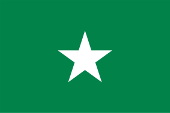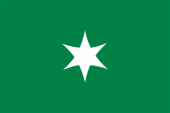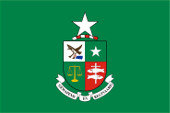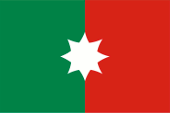Stellaland |
|
|
|
| Übersicht – Contents: | |
Diese Seite ist Teil des Projektes
Stellaland |
|
|
|
| Übersicht – Contents: | |
Flaggen – Flags: |
|
 |
1883–1884, |
 |
1883–1884, Variante, |
 |
1883–1884, |
 |
1884 (?), |
| Es gab die sogenannte "Standarte", ein grünes Tuch mit dem Wappen darin. Das war die Flagge der Regierung, wenn man so will die Staatsflagge. Sie wurde 1885, zum Ende der Republik, an Königin Victoria von Großbritannien zum Schutz übergeben und in Windsor Castle aufgehängt, wo sie bis 1934 verblieb. In jenem Jahr gab König George V. die Flagge an Südafrika zurück. Die Nationalflagge war einfarbig grün und zeigte einen silbernen fünfzackigen Stern. Einige Quellen zeigen einen Stern mit sechs Zacken. Eine weitere Flagge ist senkrecht grün-rot gestreift mit einem achtzackigen weißen Stern in der Mitte. Ihr Ursprung ist nicht geklärt. Auch die Flagge war in britischer Verwahrung und auch sie wurde 1934 an Südafrika zurückgegeben. Manchmal wird angenommen, dass diese Flagge geschaffen wurde, als sich Goshen mit Stellaland zu den Vereinigte Staaten von Stellaland vereinigte. Darüber ist aber nichts bekannt. |
There was the so-called
"standard", a green bunting with the coat of arms in the middle. That was
the flag of the government, the state flag if you will. It was given to
Queen Victoria of United Kingdom for protection in 1885, at the end of the
Republic, and hung in Windsor Castle, where it remained until 1934. That
year, King George V. returned the flag to South Africa. The national flag was solid green and featured a white five-pointed star. Some sources show a star with six points. Another flag has vertical green and red stripes with an eight-pointed white star in the middle. Its origin is not clear. The flag was also in British custody and it too was returned to South Africa in 1934. It is sometimes believed that this flag was created when Goshen united with Stellaland to form the United States of Stellaland. But nothing is known about it. |
| Quelle/Source: Wikipedia (EN) | |
Wappen – Coat of Arms: |
|
 |
1883, Wappen von Stellaland – coat of arms of Stellaland, Quelle/Source, nach/by: Flags of the World |
| Das Wappen wurde wahrscheinlich 1883 geschaffen. Es ist gevierteilt und zeigt im ersten Feld, auf Silber, eine Hand aus einem Ärmel, die einen auffliegenden Korhaan-Vogel festhält, im zweiten Feld, auf Grün, einen silbernen fünfzackigen Stern, im dritten Feld, auf Blau, eine goldene Waage und im vierten Feld, auf Rot, zwei von einem Schwert durchbohrte Fische. Der Korhaan steht für den Eingeborenenhäuptling Massouw, der Stern für das Land, benannt nach einem Kometen, die Waage ist das Symbol der Gerechtigkeit und die Fische stehen für den besiegten Eingeborenenhäuptling Mankaroane. Oberhalb erscheint ein silberner fünfzackiger Stern, unterhalb ein silbernes Spruchband mit dem Staatsmotto: "Gewapend en regtvaardig" → "Bewaffnet und gerecht". Das Wappen ist in Details umstritten, weil es abweichende Abbildungen gegeben hat, auch auf Briefmarken. Der große Stern oberhalb des Wappens wird auch in Gold dargestellt. |
The coat of arms was
probably created in 1883. It is divided into quarters and shows in the first
field, on silver, a hand from a sleeve holding a flying Korhaan bird, in the
second field, on green, a silvery five-pointed star, in the third field, on
blue, a golden scale and in the fourth field, on red, two fish pierced by a
sword. The Korhaan represents the native chief Massouw, the star represents the land named after a comet, the scales are the symbol of justice and the fish represent the defeated native chief Mankaroane. A silvery five-pointed star appears above, and below a silvery banner with the state motto: "Gewapend en regtvaardig" → "Armed and just". The details of the coat of arms are controversial because there were different images, including on postage stamps. The large star above the coat of arms is also depicted in gold. |
| Quelle/Source: Wikipedia (EN) | |
|
interaktive Landkarte der Burenrepubliken und der Britischen
Kapkolonie heutige Grenzen in Rot interactive Map of the Boer's Republics and of the Cape Colony today's borders in red |
|
| Quelle/Source: Freeware, University of Texas Libraries, modyfied by: Volker Preuß |
| Zahlen und Fakten – Numbers and Facts: | |
|
|
|
|
|
|
|
|
|
|
|
|
|
1602
· die Niederländer nehmen das Land um das Kap der Guten Hoffnung in Besitz
(Kapland), Besiedlung durch Buren (Bauern niederländischer und deutscher
Abstammung, Eigenbezeichnung: Afrikaander) 1652 · Jan van Riebeeck gründet die Siedlung Kapstadt im Auftrag der Niederländisch-Ostindischen Kompanie 1806 · Großbritannien besetzt das Kapland 1814 · Großbritannien nimmt Kapland offiziell in Besitz, Gründung der Britischen Kapkolonie 1833 · Aufhebung der Sklaverei 1836–1885 · die Buren verlassen in langen Treks das Kapland in Richtung Osten und Nordosten und gründen mehrere Burenrepubliken 20.09.1882 · Gründung von Vryburg (Vrijburg), ursprünglich und bis 1882 Endvogelfontein genannt 18.01.1883 · Buren nehmen das Gebiet von Stellaland nach Verhandlungen und Bündnisverpflichtungen in Besitz 06.08.1883 · Gründung der Republik Stellaland (Republiek Stellaland) 11.10.1883 · das Land Goshen wünscht die Fusion mit Stellaland zur Bildung der Vereinigten Staaten von Stellaland (Verenigde Staten van Stellaland), das Projekt wird nicht realisiert 1884 · Großbritannien erklärt Stellaland einseitig zum britischen Protektorat 1884 · die Südafrikanische Republik stellt Stellaland unter ihren Schutz 1884 · Einmarsch britischer Truppen 30.09.1885 · Gründung der Kolonie Britisch-Betschuanaland bei Eingliederung des Gebiets von Stellaland 16.11.1895 · Auflösung der Kolonie Britisch-Betschuanaland, Angliederung an Südafrika |
|
1602
· the Dutch appropriate the land around the Cape of Good Hope
(Cape Land), settlement of Boers (farmer of Dutch and German descent,
self-designation: Afrikaander) 1652 · Jan van Riebeeck founds the smallholding Kapstadt in mission of the Dutch East Indian Company 1806 · United Kingdom occupys Cape Land 1814 · United Kingdom annexes Cape Land officially, establishment of the British Cape Colony 1833 · abolition of slavery 1836–1885 · the Boers leave Cape Land in long treks towards east and northeast and establish various Boer's republics 20th of September in 1882 · founding of Vryburg (Vrijburg), initially and until 1882 named Endvogelfontein 18th of January in 1883 · Boers take possession of the territory of Stellaland after negotiations and alliance commitments 6th of August in 1883 · founding of the Republic of Stellaland (Republiek Stellaland) 11th of October in 1883 · the Land of Goshen wants to merge with Stellaland to form the United States of Stellaland (Verenigde Staten van Stellaland), the project will not be realized 1884 · United Kingdom unilaterally declares Stellaland a British protectorate 1884 · the South African Republic places Stellaland under its protection 1884 · invasion of British troops 30th of September in 1885 · founding of the colony of British Bechuanaland with incorporation of the Stellaland area 16th of November in 1895 · dissolution of the colony of British Bechuanaland, annexation to South Africa |
| Quelle/Source: Wikipedia (EN), World Statesmen |
| "Stella" ist Latein und heißt "Stern". Das soll sich auf den "Großen Septemberkometen" beziehen, der von September 1882 bis Februar 1883 am Firmament zu sehen war, wahrscheinlich der Gründungsmythos des Landes. Dieser Komet C/1882 R1 war wahrscheinlich einer der hellsten Kometen, die je beobachtet wurden. | "Stella" is Latin and means "star". This is said to refer to the “Great September Comet,” which was visible in the firmament from September 1882 to February 1883, probably the founding myth of the country. This comet C/1882 R1 was probably one of the brightest comets ever observed. |
| Quelle/Source: Wikipedia (EN), Volker Preuß | |